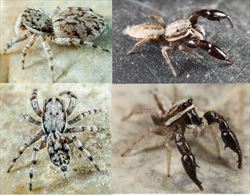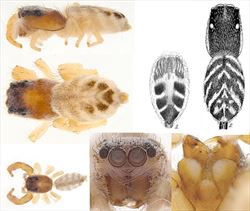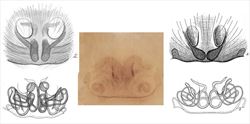
Examples of live Psenuc
Illustrator (and ©) I.R. Macaulay

Aspects of the general morphology of Psenuc
Illustrators (and ©) M. Zabka (diag,), B.J. Richardson (CSIRO)

Palp morphology of Psenuc courti
Illustrator (and ©) R. Whyte

Epigyne morphology of Psenuc
Illustrators (and ©) M. Zabka (diag.), B.J. Richardson (M) (CSIRO)
Psenuc Prószyński, 2016
Taxonomy
Psenuc is found in Africa, Asia, Australia and the western Pacific area. Australia has two described species Psenuc courti (Whyte and Anderson, 2017) and P. milledgei. Until recently, both species were placed in Afraflacilla. Related Old World genera also extending to Australia include Afraflacilla, Cosmophasis, and Menemerus. Further information on the genus can be found in Richardson and Żabka (2017) and Whyte and Anderson (2017).
Description
Psenuc spp. are small to medium-sized spiders, ranging in body length from 4 to 6 mm. The cephalothorax is rectangular with curved sides when viewed from above and low from the side. There is a curved row of 9 or 10 stridulatory tubercles on each side, extending from below the anterior lateral eye to below the posterior lateral eye. These spiny tubercles correspond with matching structures on the femur of the first leg. The tubercles on the femur are rubbed against the tubercles on the side of the head to produce sound. Chelicerae have a single (unident) tooth on the retromargin with two teeth on the promargin. The abdomen is heart-shaped to ovate, flattened or indented at the front. The first pair of legs is more massive than others, huge and fat in some males.
The male’s palp has a long, thin embolus which arcs distally from the prolateral side of the tegulum, making half a circle. The retrolateral tibial apophysis is long and tapering, arising from a strong, wide base and curving a little way away from the tegulum.
The female has two small, well-separated epigynal atria located some distance anterior to the epigastric fold. The long, highly-coiled insemination ducts lie between the atria and the epigastric fold. There are no obvious spermathecae visible externally, though a pair of large diverticulae can be seen. A pair of laterally located pockets can be seen adjacent to the epigastric fold at the posterior margins of the epigyne. These can be faint or obscure.
Biology
Specimens are mostly observed or collected on tree trunks, but sometimes on foliage. Specimens are found in woodland, open forest and beaches. The stridulatory organs in both sexes and juveniles are likely used in intraspecific communication.
Distribution
Found in higher rainfall areas in northern Australia and in New Guinea (P. courti).
References
Prószyński, J. 2016. Delimitation and description of 19 new genera, a subgenus and a species of Salticidae (Araneae) of the world. Ecologica Montenegrina 7, 4-32.
Richardson, B.J. & Żabka, M. 2017. Salticidae. Arachnida: Araneomorphae. Canberra, Australian Faunal Directory. Australian Biological Resources Study, at https://biodiversity.org.au/afd/taxa/SALTICIDAE.
Whyte, R. & Anderson, G. 2017. A Field Guide to Spiders of Australia. CSIRO Publishing: Clayton.
Żabka, M. 1993. Salticidae (Arachnida: Araneae) of the Oriental, Australian and Pacific regions. IX. Genera Afraflacilla Berland & Millot 1941 and Evarcha Simon 1902. Invertebrate Taxonomy 7, 279-295.
Żabka, M. & Gray, M.R. 2002. Salticidae (Arachnida: Araneae) from Oriental, Australian and Pacific Regions, XVI. New species of Grayenulla and Afraflacilla. Records of the Australian Museum 54, 269-274.
* The information sheet should be interpreted in the context of the associated diagrams and photographs. Diagrams explaining anatomical terms can be found in the ‘Salticidae’ pictures at the beginning of the list of genera.